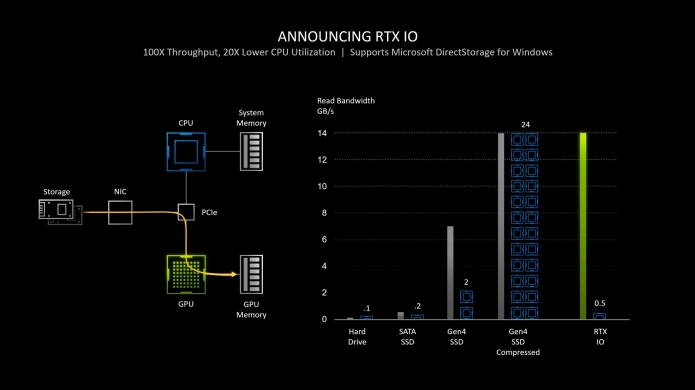Post by KostaAndreadis @ 03:32pm 03/09/20 | 1 Comments

DirectStorage is similar and in fact just about the same thing we'll end up seeing with Xbox Velocity Architecture in the Xbox Series X console. Where the key is to decompress game assets without a hit to performance and at a speed that doesn't impact streaming data into a game. For the layman, fast loading!
Here's an explanation of DirectStorage via the DirextX blog.
Existing APIs require the application to manage and handle each of these requests one at a time first by submitting the request, waiting for it to complete, and then handling its completion. The overhead of each request is not very large and wasn’t a choke point for older games running on slower hard drives, but multiplied tens of thousands of times per second, IO overhead can quickly become too expensive preventing games from being able to take advantage of the increased NVMe drive bandwidths.
On top of that, many of these assets are compressed. In order to be used by the CPU or GPU, they must first be decompressed. A game can pull as much data off the disk as it wants, but you still need an efficient way to decompress and get it to the GPU for rendering. By using DirectStorage, your games are able to leverage the best current and upcoming decompression technologies.
In a world where a game knows it needs to load and decompress thousands of blocks for the next frame, the one-at-a-time model results in loss of efficiency at various points in the data block’s journey. The DirectStorage API is architected in a way that takes all this into account and maximizes performance throughout the entire pipeline from NVMe drive all the way to the GPU.
Of course it's an involved and technical process, and that explanation is a little confusing for us mere mortals.
Where NVIDIA RTX IO steps into the picture and say "what-up my dudes, I hear you be worrying about loading times" is for all of that NVMe data to head straight into the GPU, uncompressed, and bypass the CPU. With super-fast NVMe speeds (Gen3 and Gen4) the power of the latest 30 series RTX GPU will then handle the decompression. According to NVIDIA, right off the bat this process improves speed by a factor of 2 and dramatically cuts down CPU usage in the process. And this all happens at speeds faster than the NVMe drive itself.
“Microsoft is delighted to partner with NVIDIA to bring the benefits of next generation I/O to Windows gamers," Bryan Langley, Group Program Manager for Windows Graphics and Gaming said. "DirectStorage for Windows will let games leverage NVIDIA’s cutting-edge RTX IO and provide game developers with a highly efficient and standard way to get the best possible performance from the GPU and I/O system. With DirectStorage, game sizes are minimized, load times reduced, and virtual worlds are free to become more expansive and detailed, with smooth & seamless streaming.”
So yeah, Bryan from Windows Gaming is spot on. What it means is super-fast loading. And with next-gen consoles like the PlayStation 5 and Xbox Series X offering not only high-speed NVMe storage, but this sort of technology, we can now tick that box off on the PC front.
Add in some NVIDIA RTX IO, and it will be handled on the GPU side and improve performance to boot. Though with the RTX 30 series handling ray-tracing, DLSS rendering, and now IO, we're hoping that the 3080 takes a break between frames to simply chill.
Head here for all the skinny on the new RTX 3080, RTX 3070 and chunky RTX 3090
Latest Comments




















Posted 04:47pm 03/9/20